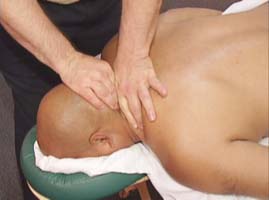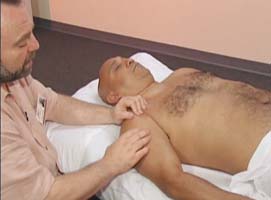Thoracic Outlet Syndrome Relief
Pathogenesis
The pathogenesis of thoracic outlet syndrome can be linked with the anatomy of the anterior scalene muscle. The anterior scalene muscle starts from the transverse processes of C3-C6, slanting downward and forward, and inserts into the first rib. When it contracts, the head bends to the same side and forward.
The causes of anterior scalene muscle syndrome are:
- Cervical spondylosis – Spinal nerves C3-C8 provide motor innervation to the anterior scalene muscle. Their irritation or compression evokes increased tension in the anterior scalene muscle.
- Chronic overload and muscular strain – Chronic physical overload of the anterior scalene muscle or its strain also produces the clinical picture of anterior scalene muscle syndrome. Because the anterior scalene muscle participates in respiration, patients with bronchial asthma frequently have anterior scalene muscle syndrome.
- Visceral pathology – The heart and lungs are innervated by the same segments of the spinal cord as the anterior scalene muscle. Thus, chronic cardiac and pulmonary disorders evoke reflex zones in the anterior scalene muscle and are responsible for anterior scalene muscle syndrome. Radiating pain to the left arm caused by this syndrome can also mimic heart pathology.
The brachial plexus is located between the anterior scalene and middle scalene muscles. If the tone of the anterior scalene muscle is elevated, the brachial plexus is found in the sphincter between these two muscles. As a result, the brachial plexus becomes chronically irritated and produces a rich neurological picture. The spinal nerves of C7-C8 are involved to the greatest degree (C6-C7 and C7-T1 segments of spine.)Anterior scalene muscle syndrome causes an abundance of circulatory problems. The subclavian artery and vein pass between the anterior scalene muscle and the first rib. An over-tensed muscle can compress the artery and vein, or evoke their vasospasm by irritation of the brachial plexus. Compression of the subclavian artery produces symptoms of insufficient blood supply to the upper limb; compression of the subclavian vein produces symptoms of insufficient blood drainage (edema). Additionally, the anterior scalene muscle can compress the vertebral artery or evoke vasospasm by irritating its sympathetic plexus.
Clinical symptoms
The main clinical symptom is pain that increases: at night, during deep breathing, when the head is bent and turned to the unaffected side, and when the arm is abducted. The pain spreads to the shoulder, armpit and lateral part of the thoracic cage. Also, patients complain about numbness and paraesthesia on the ulnar edge of the hand (hypothenar and 4th-5th fingers) and arm. One of the most important diagnostic signs is diversity of vasomotor changes. These can be the result of insufficient arterial blood supply to the arm (pain in the hand especially after exposure to lower temperatures; pale, cold skin; cyanosis; weak pulse) or insufficient venous blood drainage from the arm (edemas and increased skin temperature). If anterior scalene muscle syndrome exists for a long period of time, without adequate treatment, the hand will lose its strength because of muscle atrophy mostly at the ulnar edge of the arm and the hypothenar.
An important clinical sign involves Wartenberg’s test. If the examiner palpates in the spot where the anterior scalene muscle inserts into the first rib, local pain will appear. This test allows the practitioner to differentiate anterior scalene muscle syndrome can secondarily evoke rotator cuff syndrome. This is a very important diagnostic test because irritation of the brachial plexus by an over-tensed anterior scalene muscle can secondarily evoke rotator cuff syndrome. if the practitioner mistakenly starts treatment of this pathology as a rotator cuff syndrome, it will not yield significant results because the real cause of the problem is anterior scalene muscle syndrome.
Thoracic Outlet Syndrome Protocol
The pictures offered below as steps illustration are the actual snapshots from the instuctional medical massage educational video #4
Place the client face down.
| Step 1 Perform combination of effleurage and friction on all areas of the upper back. |
 |
| Step 2 Work in the inhibitory regime, perform petrissage #1 and 2 on all areas of the upper back including the trapezius. |
 |
| Step 3 Perform petrissage #3 on the neck for 3-4 minutes. |  |
Turn the client face up.
| Step 1 Turn the patient’s head fourty five degrees to the unaffected side. |  |
| Step 2 With thumbs, shift upwards (medially) the sternocleidomastoid muscles and compress the anterior scalene muscle. Apply initial pressure from approximately C3 level, and in a circular motion, massage the anterior scalene muscle down towards its insertion (try to reach this place of insertion) into the first rib. Repeat this technique 5-6 times. |  |
| Step 3 Palpate to detect any trigger points in the area, especially where they are commonly found approximately in the middle of the belly of the anterior scalene muscle. Of course, it is important to detect all trigger points. |  |
| Step 4 Once a trigger point is discovered, hold a finger over its place but do not compress (yet). Turn the head to the same side, and slowly apply ischemic compression. |  |
| Step 5 With one hand fix the scalene on the level of C3, and with the other hand, fix the scalene at the C7 level. Slowly pull hands apart to apply traction on the anterior scalene muscle. |  |
| Step 6 Perform massage; effleurage and friction on all areas of the forearm and arm. |  |
| Step 7 Palpate to discover all possible trigger points in the arm. Eliminate all detected trigger points with ischemic compression. |  |
To get familiar with the description of the the medical massage educational video featuring Thoracic Outlet Syndrome protocol please click here.





